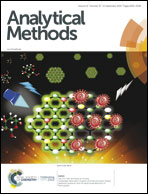Sustainable fabrication of green luminescent sulfur-doped graphene quantum dots for rapid visual detection of hemoglobin†
Abstract
In this work, sulfur-doped graphene quantum dots (S-GQDs) with stable green fluorescence were successfully synthesized by hydrothermal pyrolysis in the presence of glucose and mercaptosuccinic acid as the carbon and sulfur sources, respectively, for rapid and sensitive detection of hemoglobin (Hb). The as-prepared S-GQDs have a uniform size with a mean particle diameter of 4.5 ± 0.5 nm and an excellent quantum yield of 71%. The high sulfur content of 3.7% in the S-GQD network can not only increase the quantum yield of S-GQDs but also enhance the electron density of S-GQDs for effective Hb detection through π–π interactions. The S-GQDs exhibit an excellent sensitivity toward Hb detection and a linear range of 10–1000 nM with a low limit of detection of 0.28 and 0.48 nM in phosphate buffer solution and human serum, respectively, is observed. Moreover, the fluorescence response of S-GQDs exhibits high selectivity toward Hb over 16 other interferents including metal ions, amino acids, and proteins. The results in this work clearly demonstrate the easy and facile fabrication of S-GQDs for sensitive and selective detection of biomolecules without surface modification, which can open a new way to develop highly efficient and robust sensing probes for the detection of biomarkers, metal ions and organic metabolites in biological applications.



 Please wait while we load your content...
Please wait while we load your content...